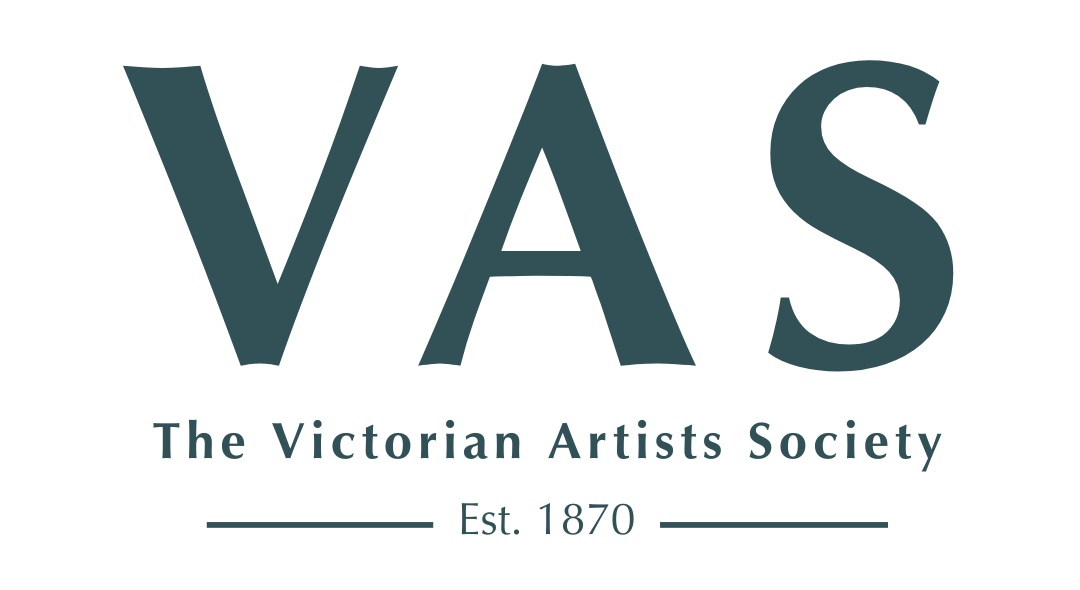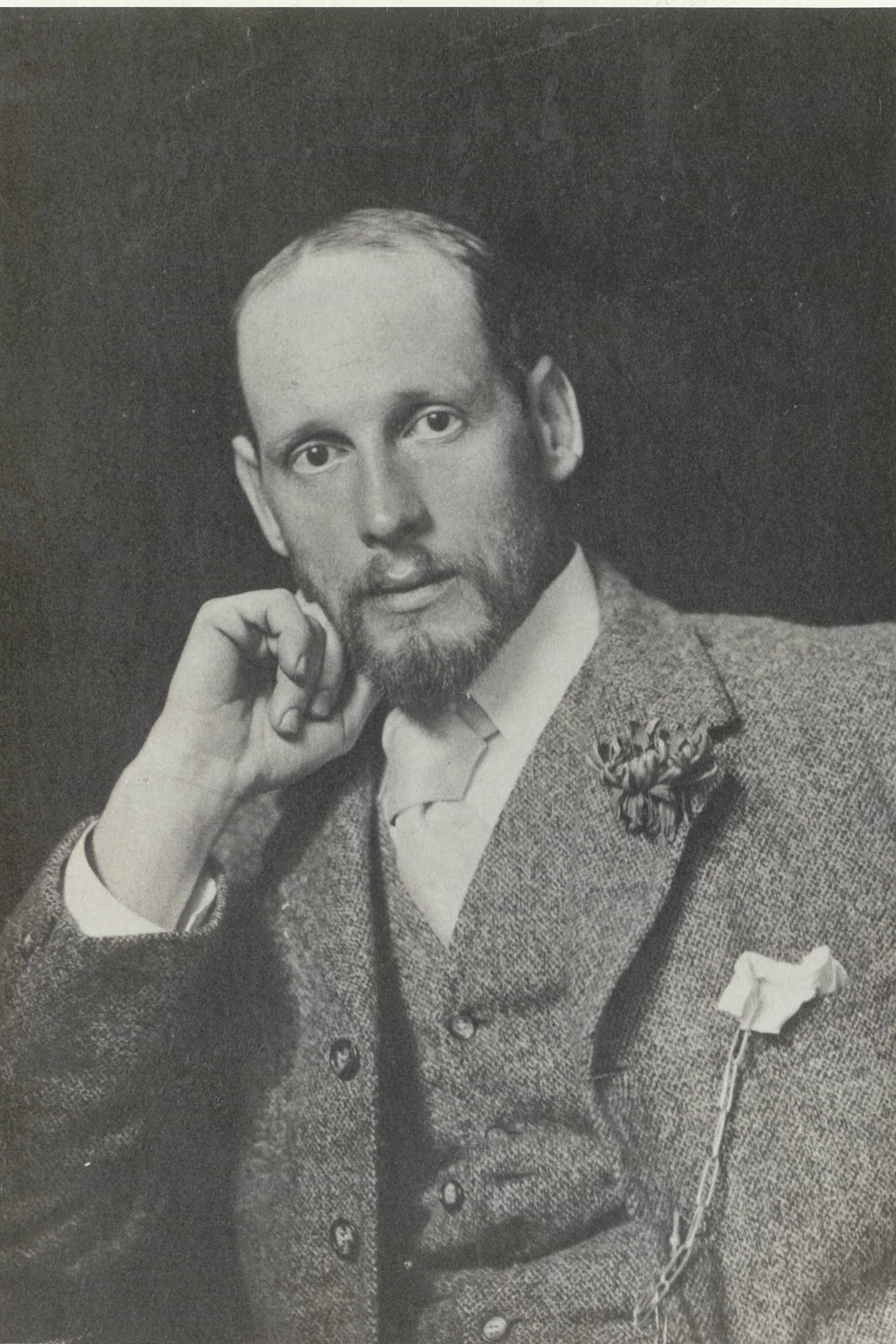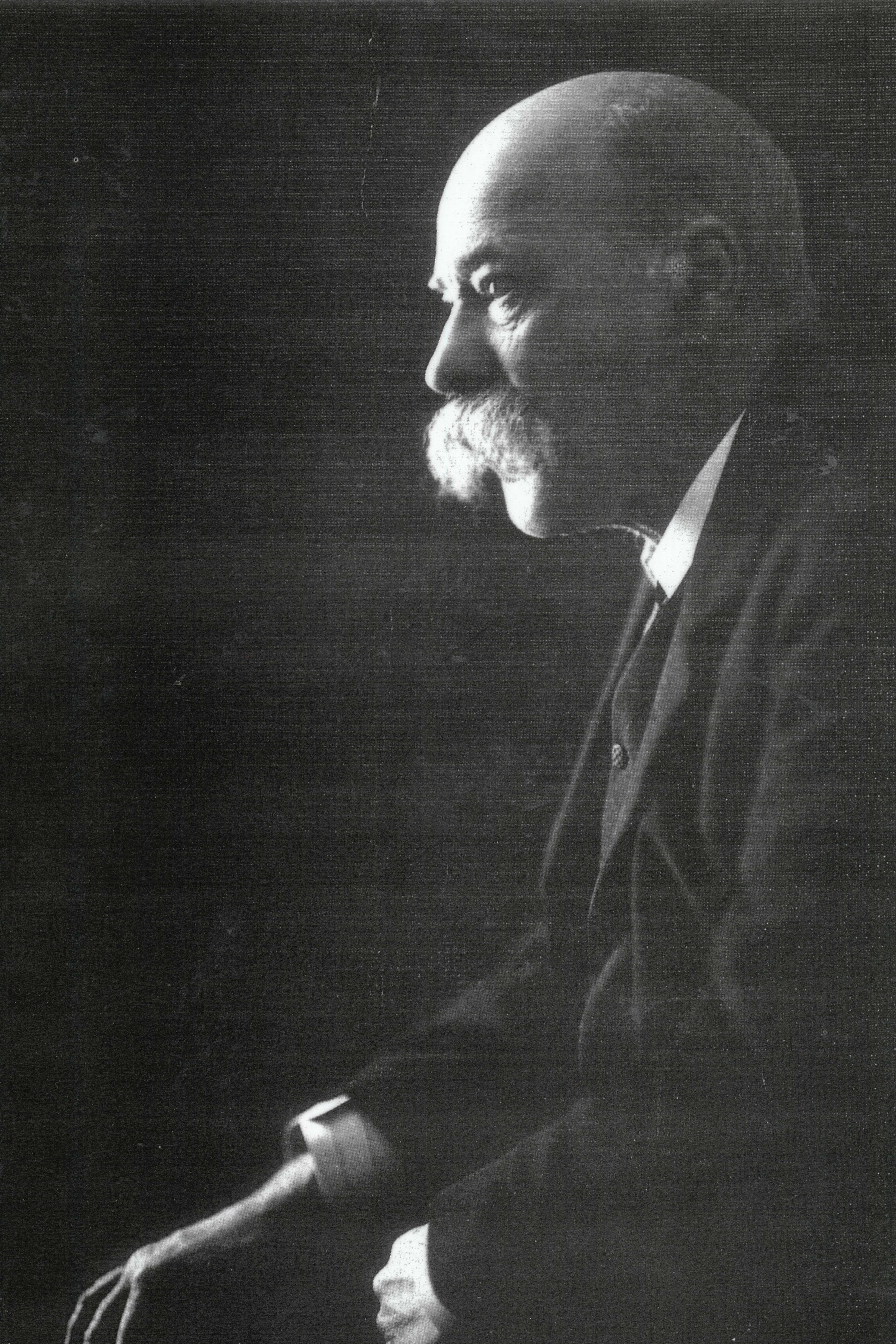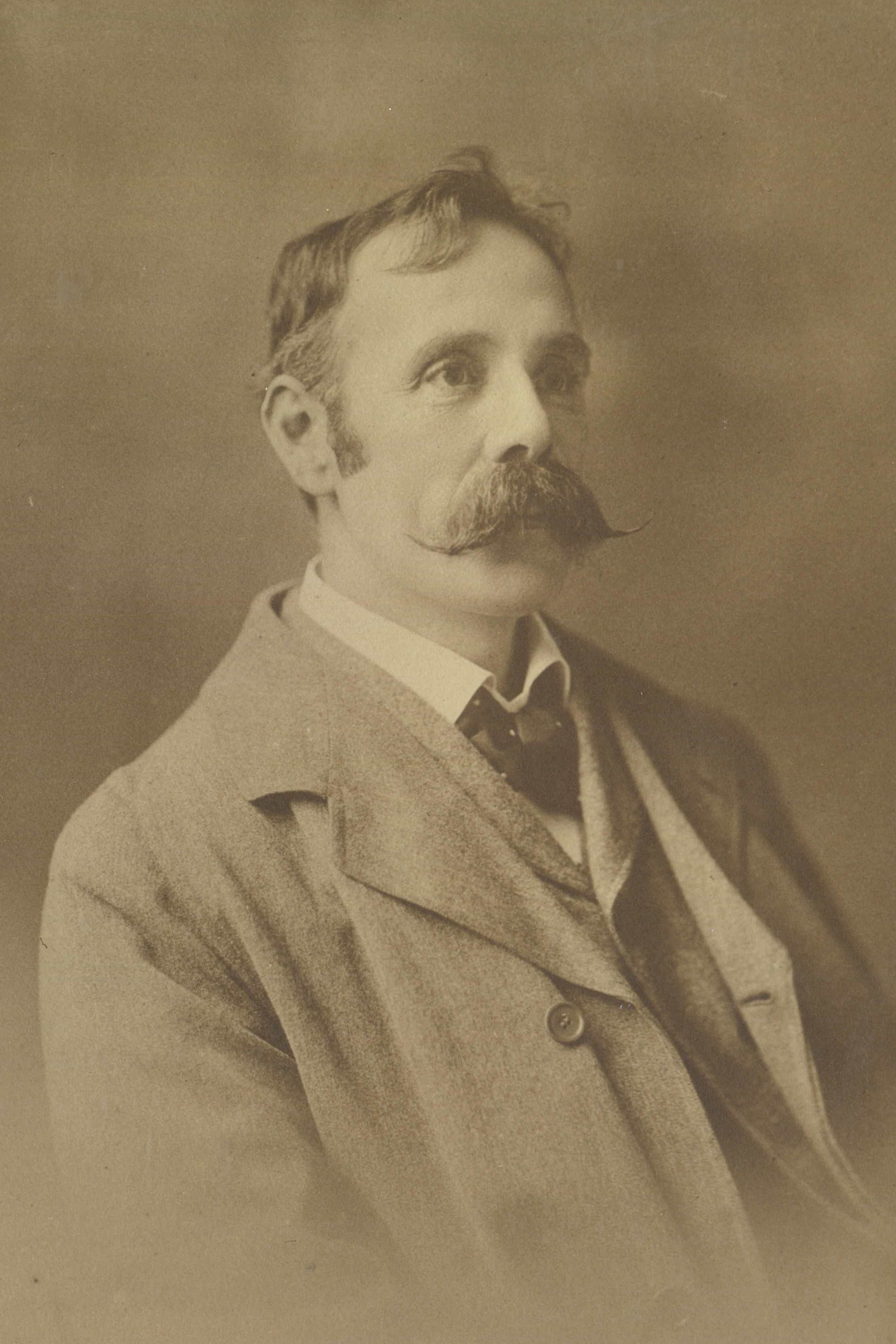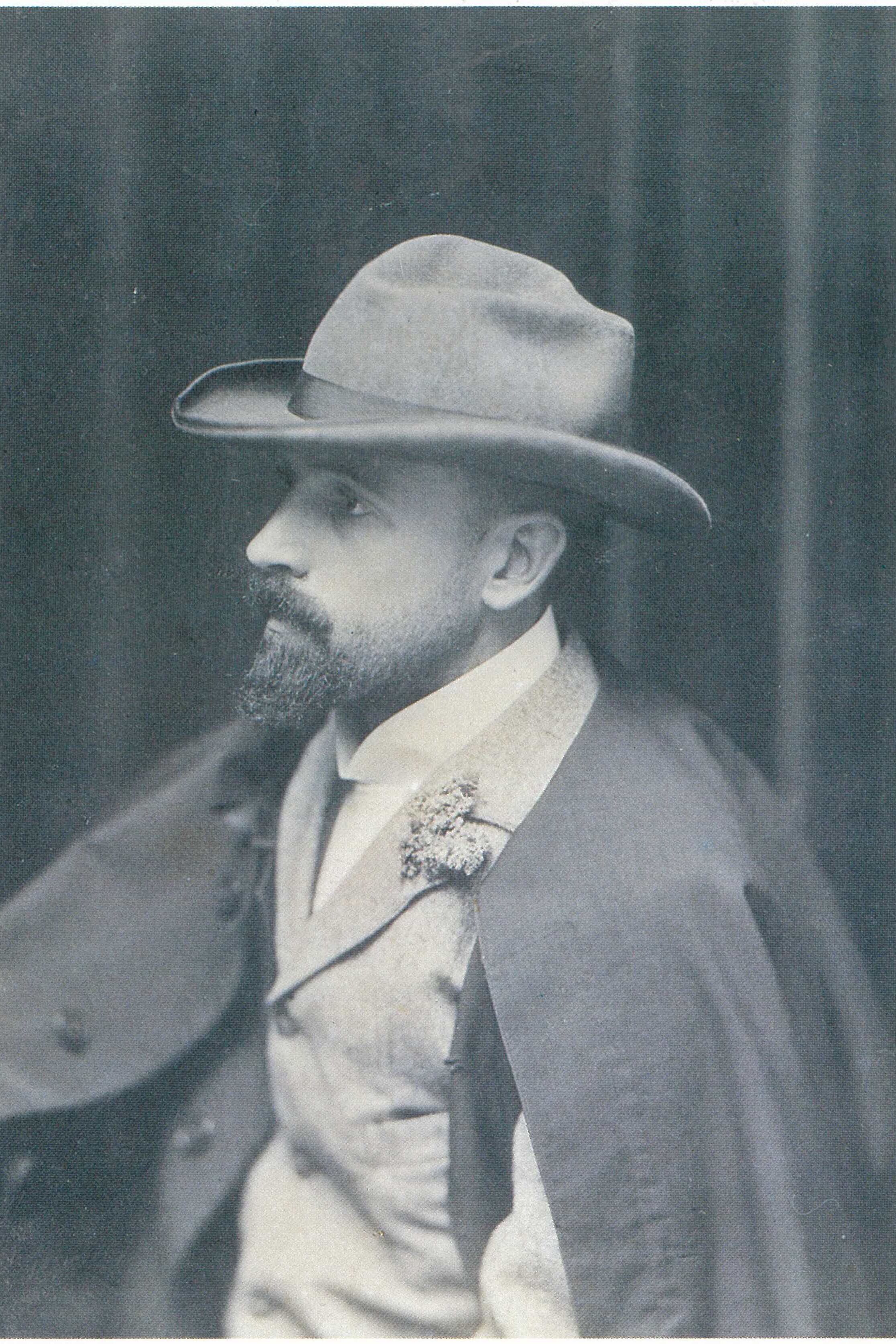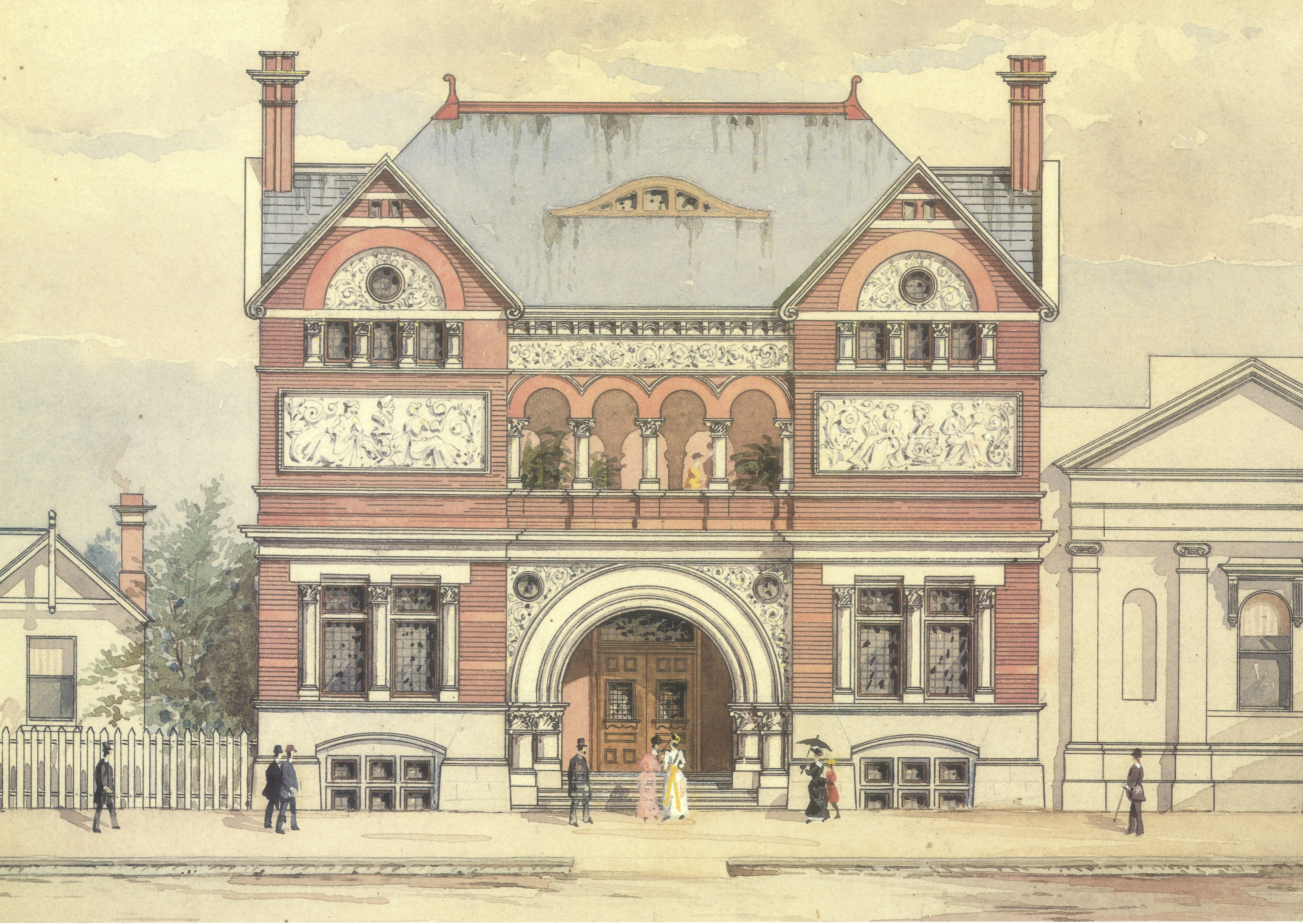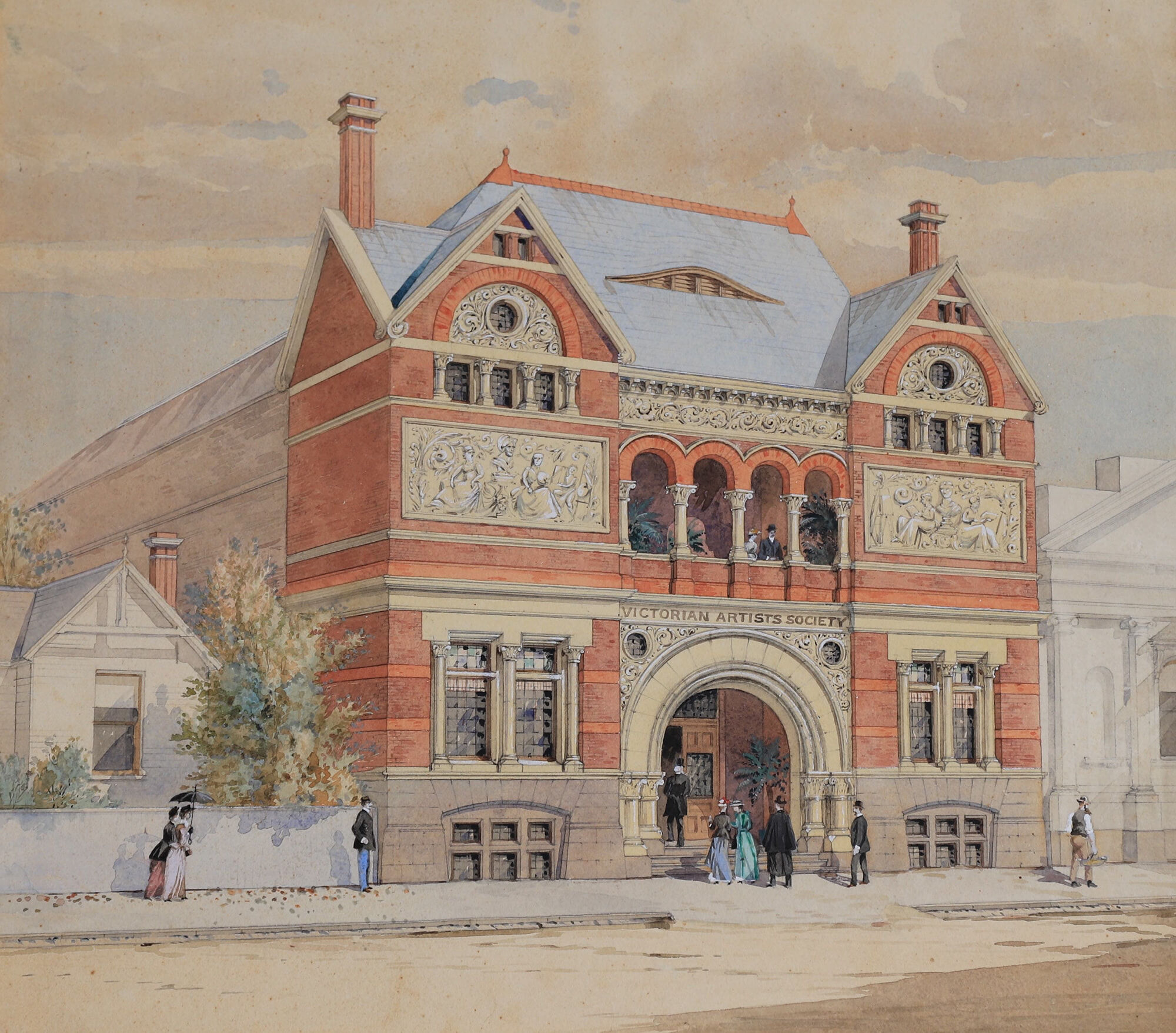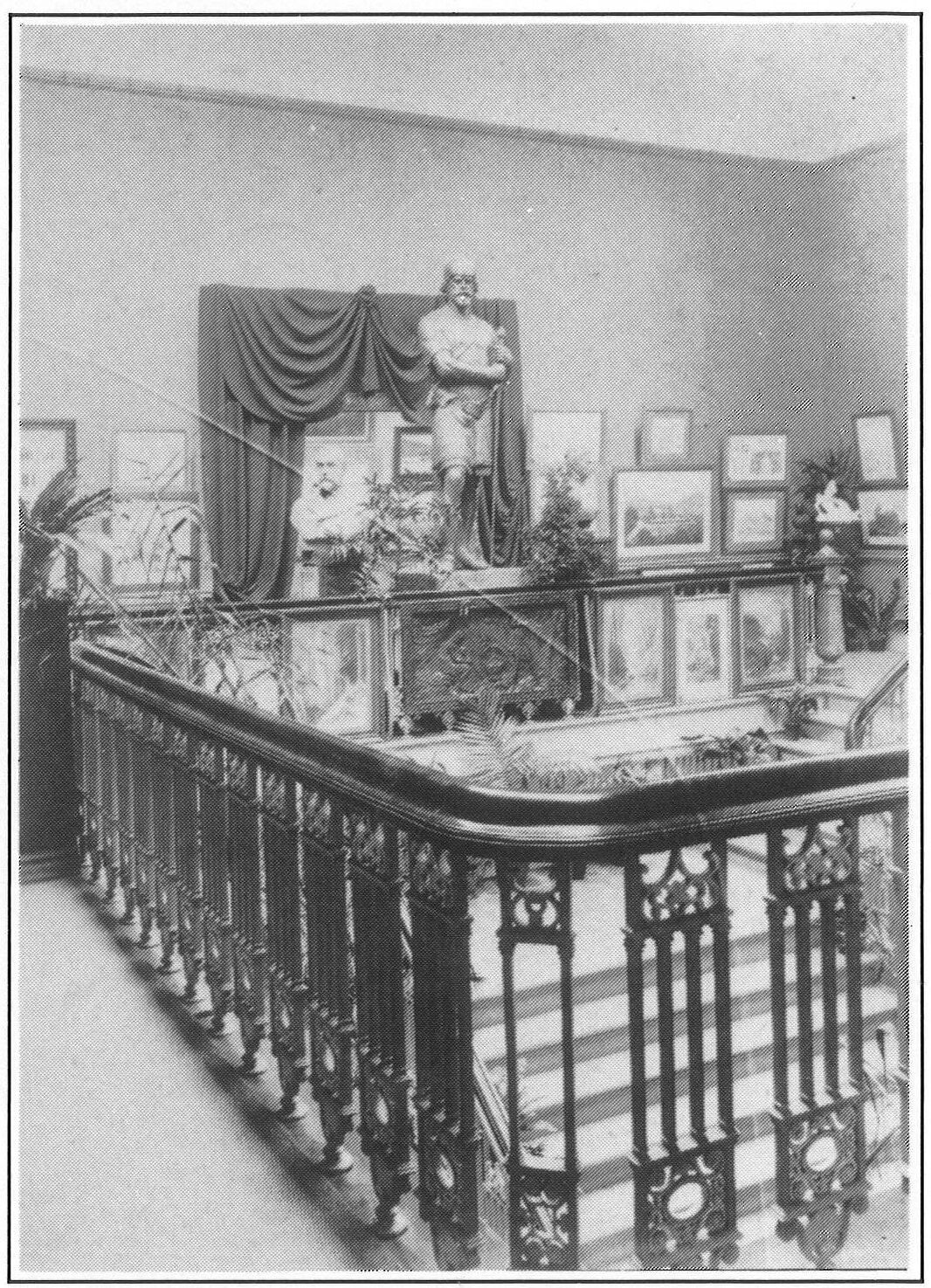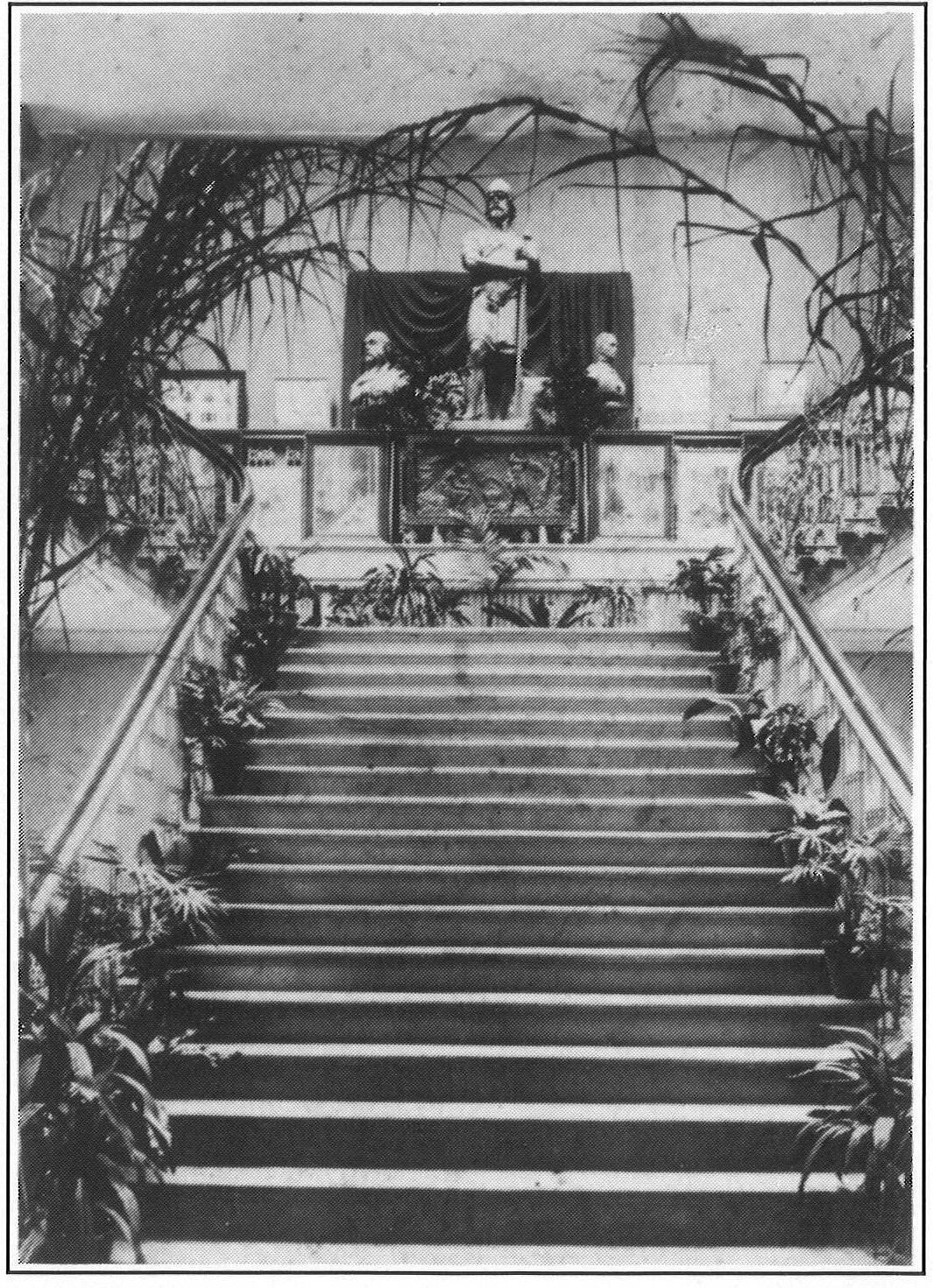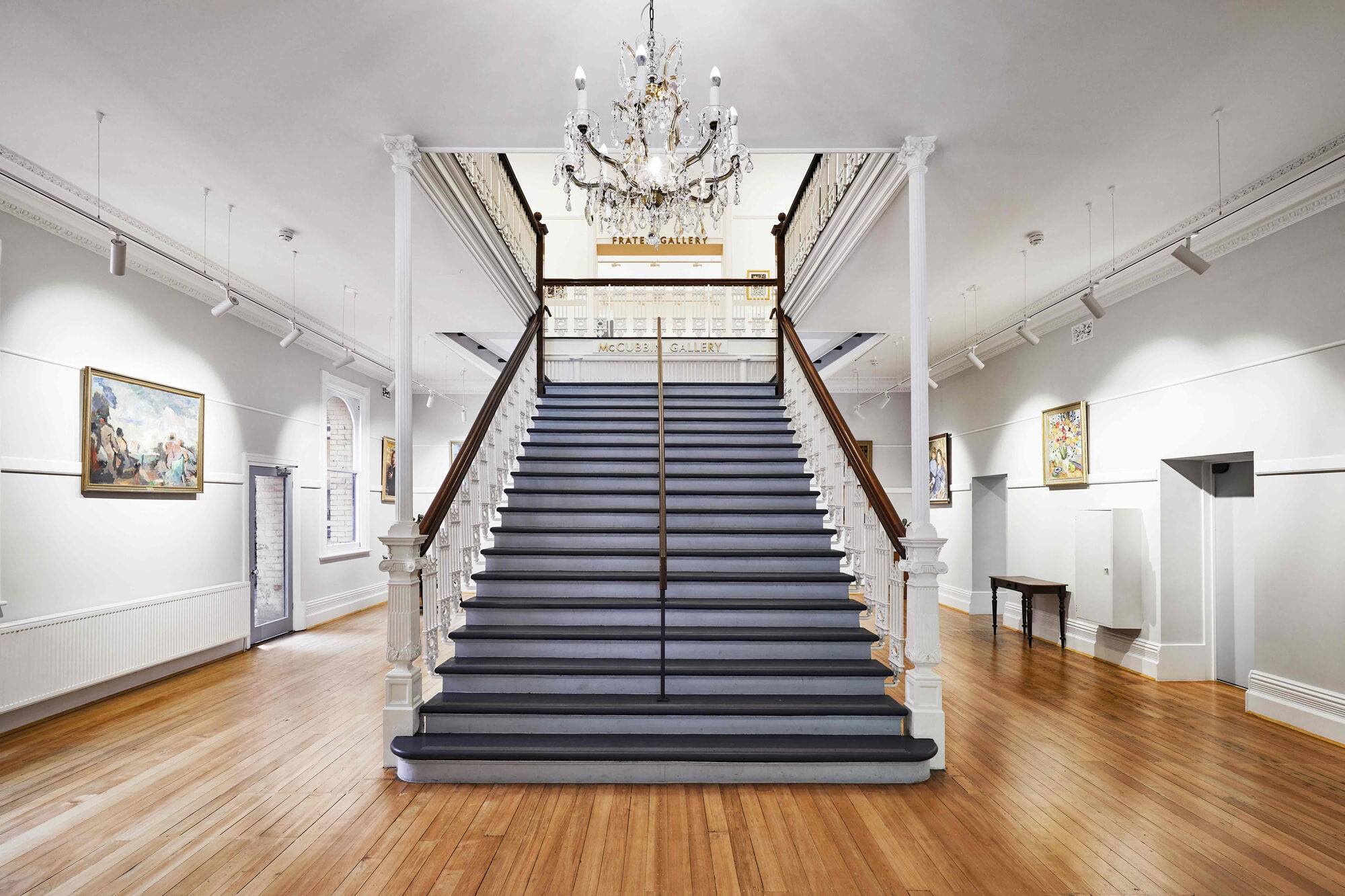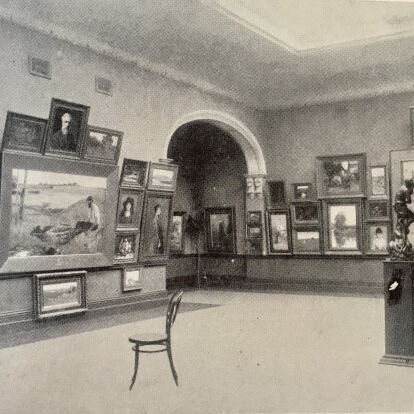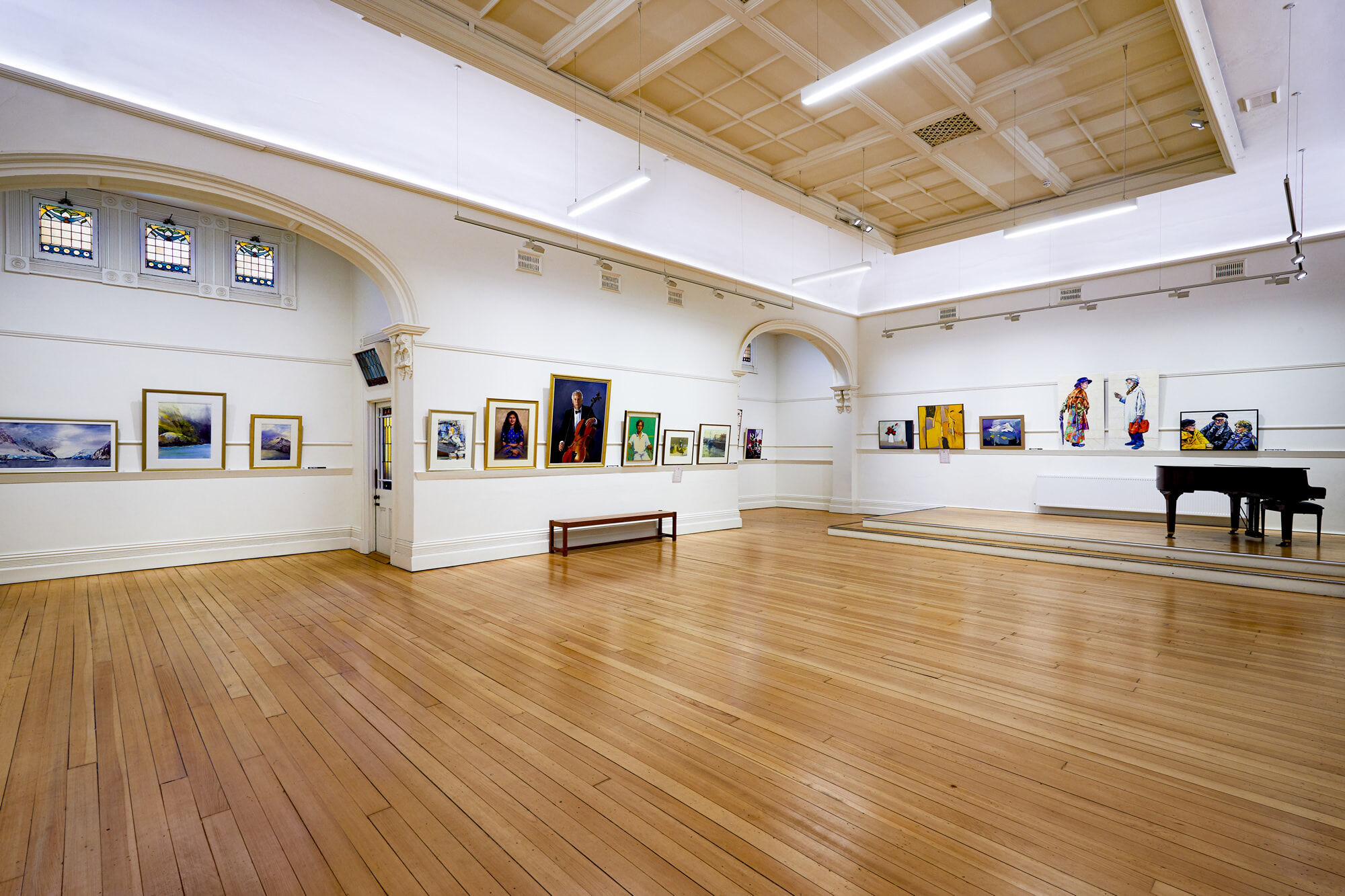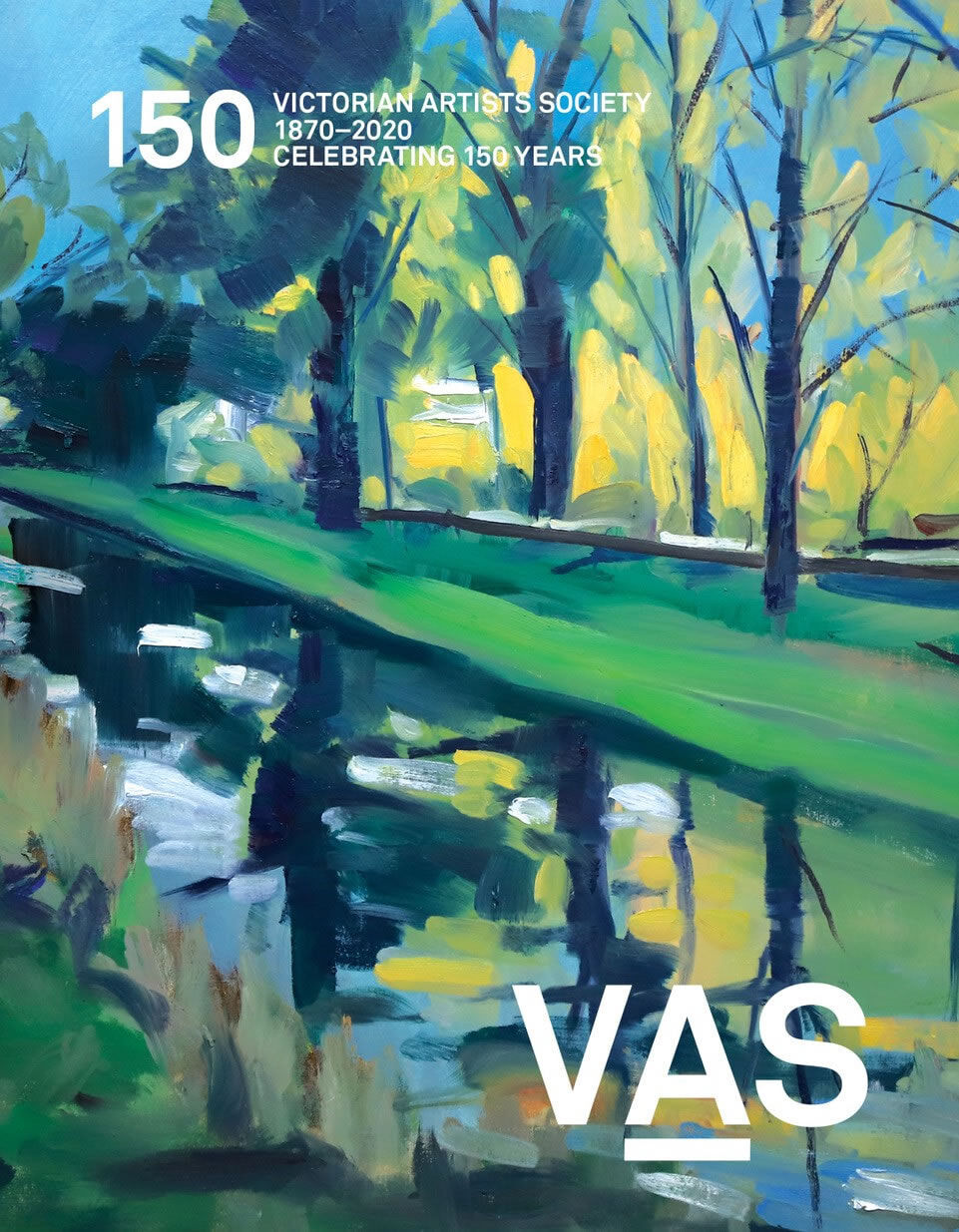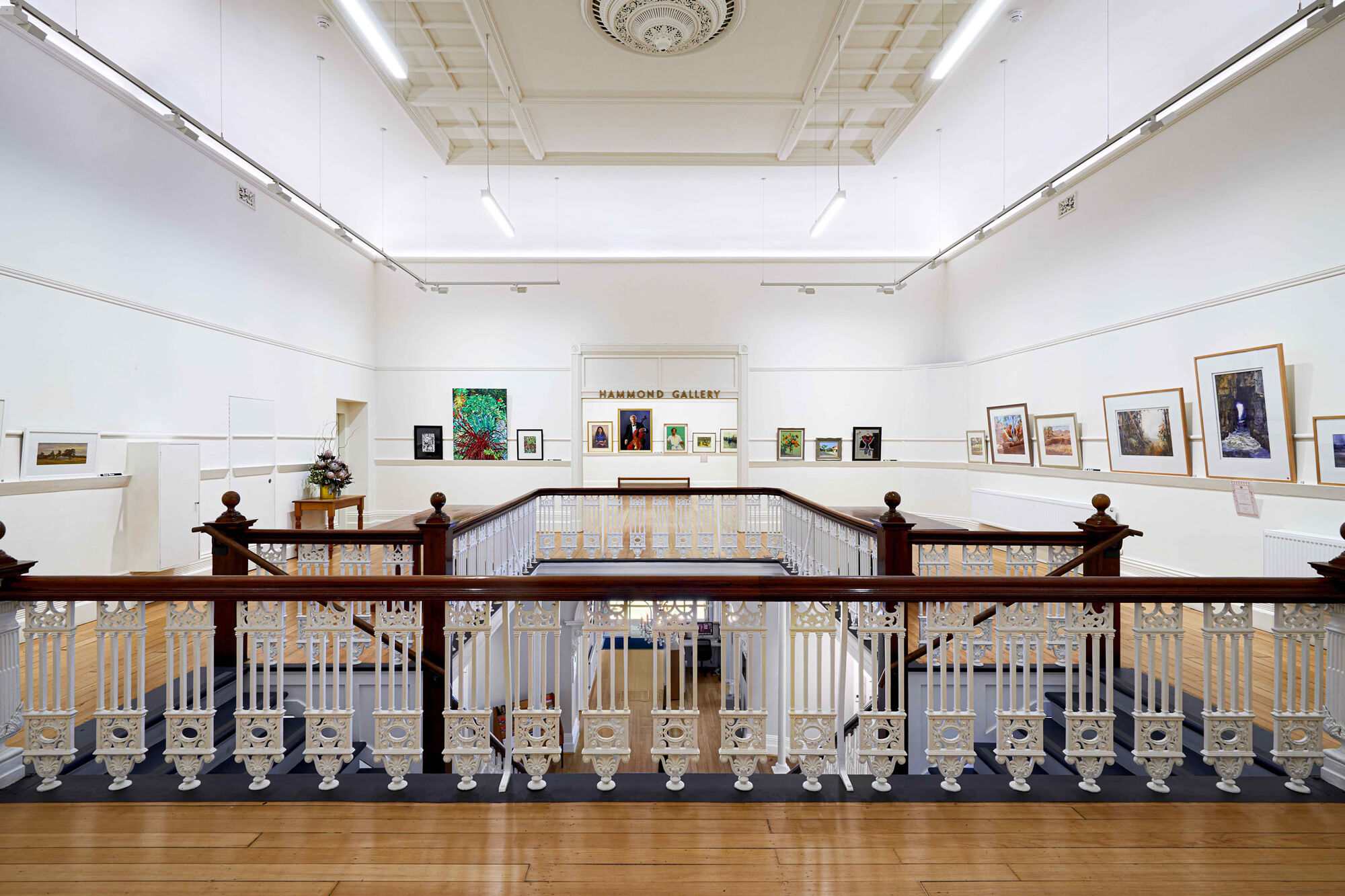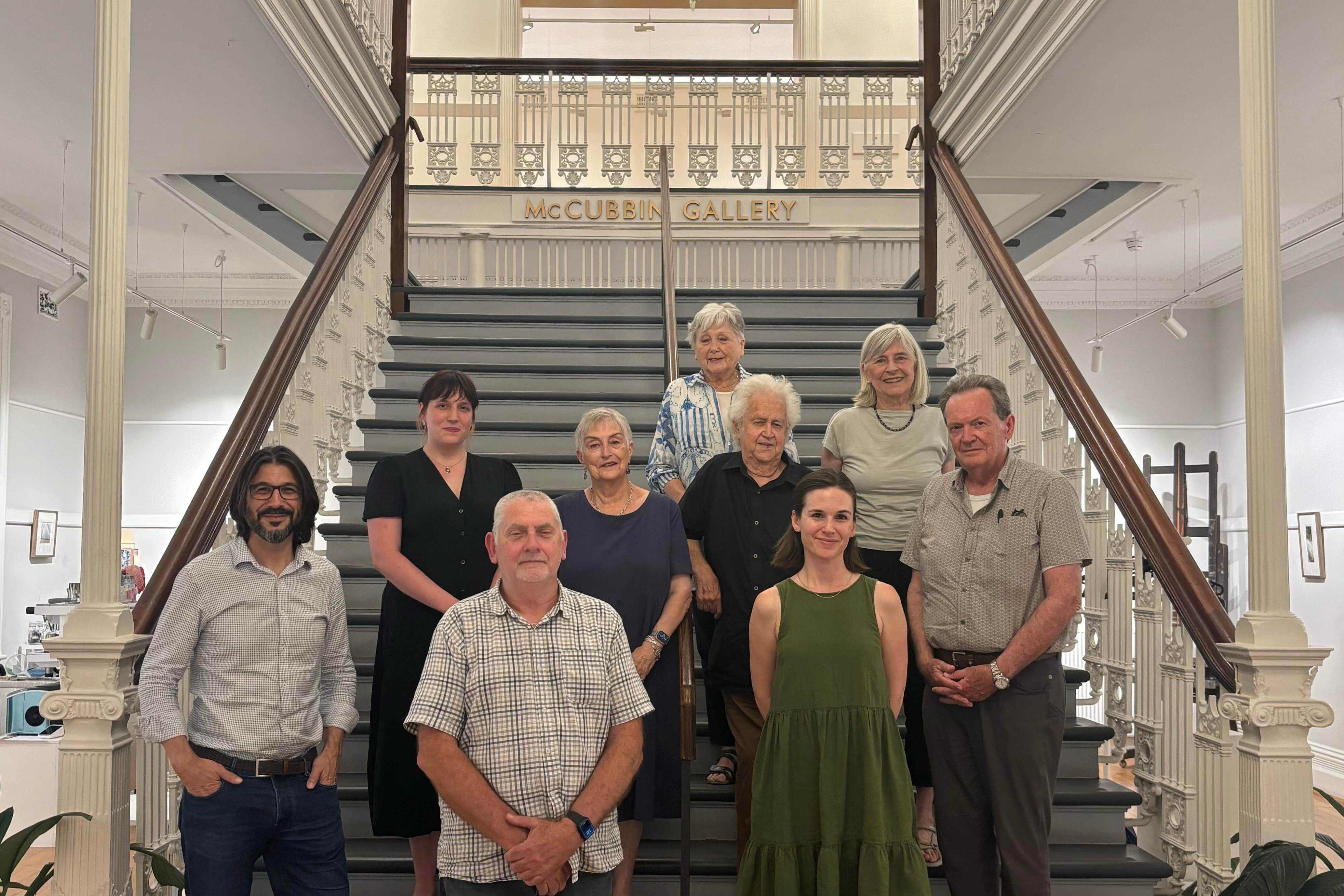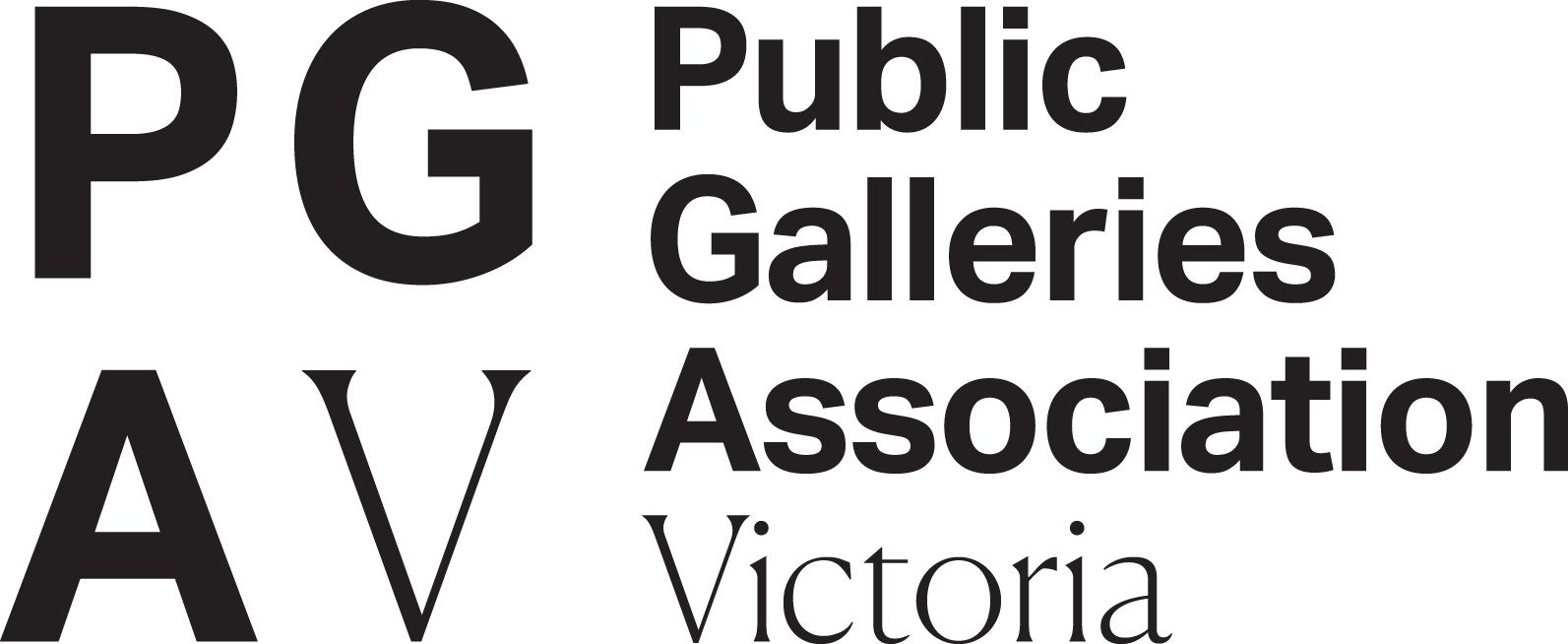Timeline of the victorian artists society
1870
The Victorian Artists Society had its beginnings in 1870 when a small group of artists and lay persons met in magistrate James Robertson’s house at Blessington Street, St. Kilda, to form the Victorian Academy of the Arts, the direct ancestor of VAS.
Among the founders were Louis Buvelot, JA Panton, Thomas Clark and Hubert de Castella. This heavyweight group was instrumental in not only securing the Crown Land Grant on which our building now stands, but in the early establishment of the Society as a legal entity.
1874
The original bluestone studio building was opened in 1874 following the grant of land on Albert Street—a single-storey construction without windows that earned the nickname of ‘the morgue’. Although almost totally subsumed by the present building, the building still serves both as a studio and a reminder of our history. It was built by Corben and Stuart and designed by architect Leonard Terry, who had worked principally as a designer of warehouses and banks—an influence seen in the solid and conservative style of the original gallery which also reflects the society’s humble beginnings. At the time of its construction the media mocked it severely.
‘As external matters at present stand, the Victorian Academy of Arts is lodged in a gallery rising from amidst a waste of water-pipes, and rivalling in ugliness the anathematise water-tanks’
(The Age 1874, p. 3)
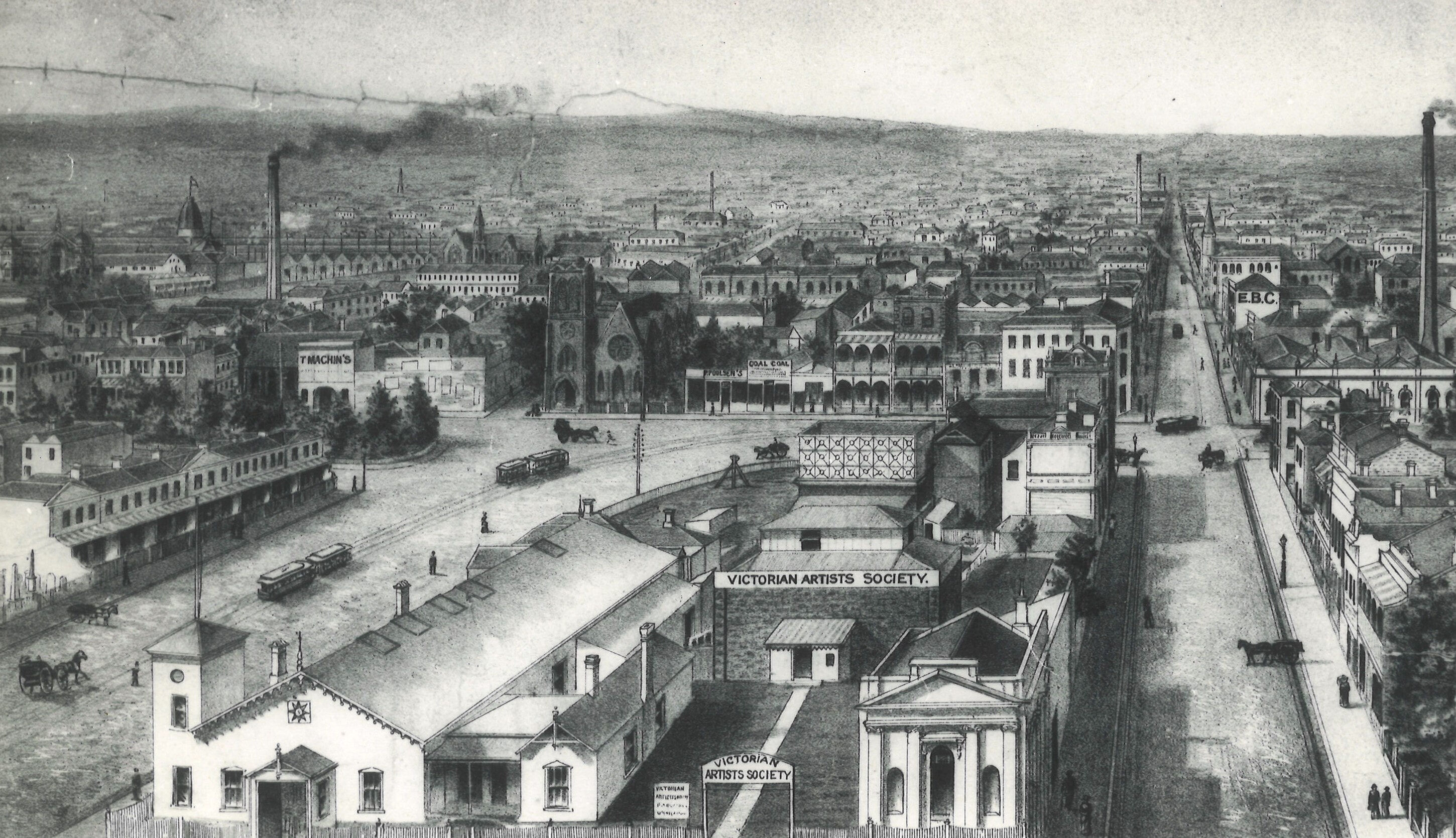
Early panorama of Fitzroy. A parcel of land was allocated to the Society in Albert Street East Melbourne by the colonial Governor, on which was built a bluestone building 'designed for the purposes of Art'.
1888
The extension of the building in the last decade of the nineteenth century was necessitated by the formation of the Victorian Artists Society and the increase in the number of members.
In 1886 the professional artist members, led by Arthur Streeton, Tom Roberts and Charles Conder, had split off to form the Australian Artists Association. Talks later commenced in 1887 to unite the Victorian Academy of the Arts and the Australian Artists Association, forming the modern Victorian Artists Society.
Amateur painter and Police Officer Joseph Panton was elected President of this new Society now known as the Victorian Artists Society. Newly formed, there were already 800 members, made up of both professional painters and subscribers.
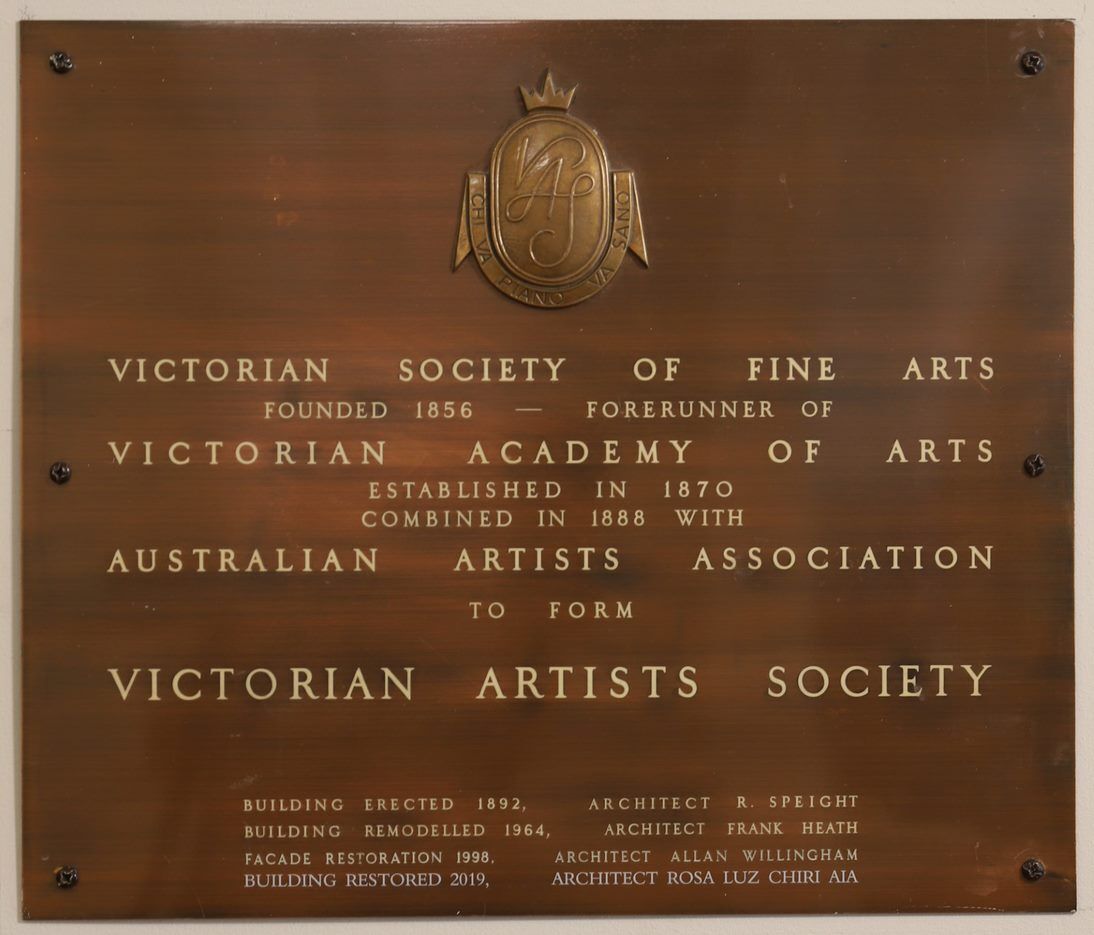
1892
If the original building was ridiculed for its hideousness, the modern two storey gallery and façade has earned a listing as a heritage building and is regarded as one of the best examples of Romanesque architecture in Melbourne. The building was designed by Richard Speight Junior, who won the competition for its design. The winning tender was submitted by William Massey and the building completed in 1892. It is made iconic through its high standard of decorative mouldings, columns and beautiful façade. The façade of the building owes much to the American Romanesque tradition, pioneered by American architects Richardson and Sullivan. The detailing of the interior is more Victorian in character. The building is essentially intact apart from minor 20th century alterations.
1895
WILLIAM TAYLOR TIBBITS
1837–1906
Tibbits spent the early part of his life in Ballarat, Victoria, moving to Melbourne in 1875 to pursue a career as a landscape painter, lithographer, engraver and professional artist specialising in commissions of stately homes and public buildings.
He offered his professional services to capture in paint the majestic, architectural beauty of numerous Vice Regal dwellings, grand hotels and many other significant properties throughout Victoria.
This painting of the façade of our Albert Street building, is a lovely example of his detailed and finely executed work.
Painted around 1895, it is the earliest record of how we looked back then, an elegant addition to the area known as ‘Eastern Hill.’
1898
In 1898, our ground floor Gallery was hired out as a Conservatorium of Music and many notable musicians, including Dame Nellie Melba, taught both singing and instrumental classes within its walls.
For the next few decades it remained as a teaching studio, bringing in much needed revenue for the Society.
But by the early 1950s, it was reclaimed as a Gallery and was named the ‘Cato’, after local physician Dr Edwin Cato, art lover and benefactor, endowed the Society with a generous sum of money.
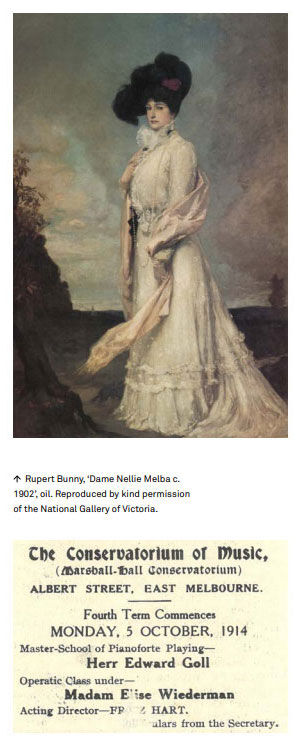
1900
For many years 'Smoke Nights' took place on a Friday night.
The gentlemen VAS members enjoyed good liquor and rare roast beef sandwiches whilst listening to the bawdy ditties and popular poems of the era, sung and recited by Walter Withers and other prominent members.
These were ‘Gentlemen Only’ occasions, but it was observed that several ‘young ladies unknown to the Society’ were frequently smuggled upstairs, ‘on the arms’ of several not so discreet male artists.
While singing and carousing took place in the Hammond gallery, these young women enjoyed a glass or two of Champagne on the balcony beneath the light of the moon shining above St. Patrick’s Cathedral opposite.
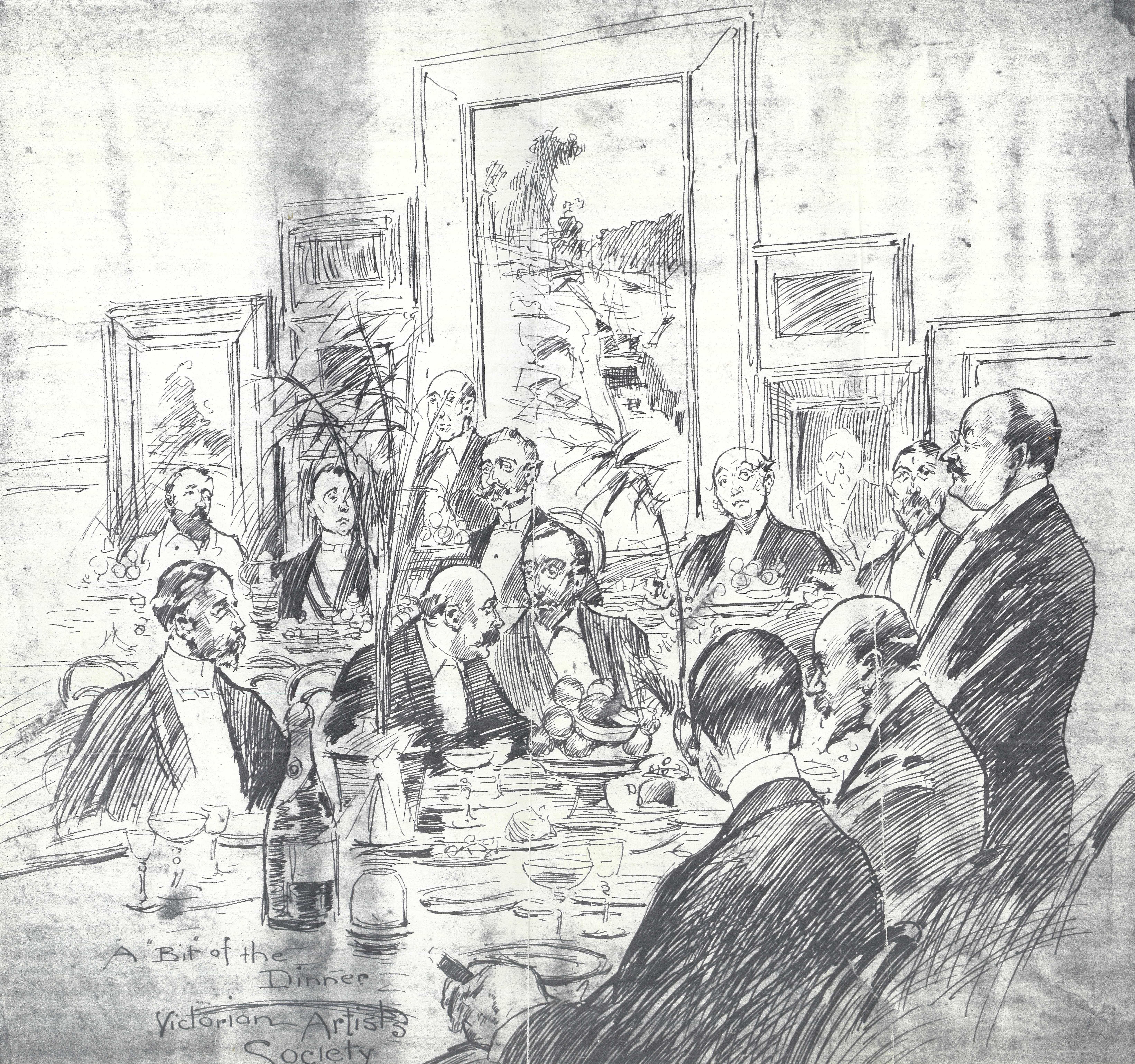
1904
By 1904, there were a number of women on the VAS Council, including Clara Southern, Josephine Muntz-Adams and May Vale. Half the Society’s exhibiting members were in fact women.
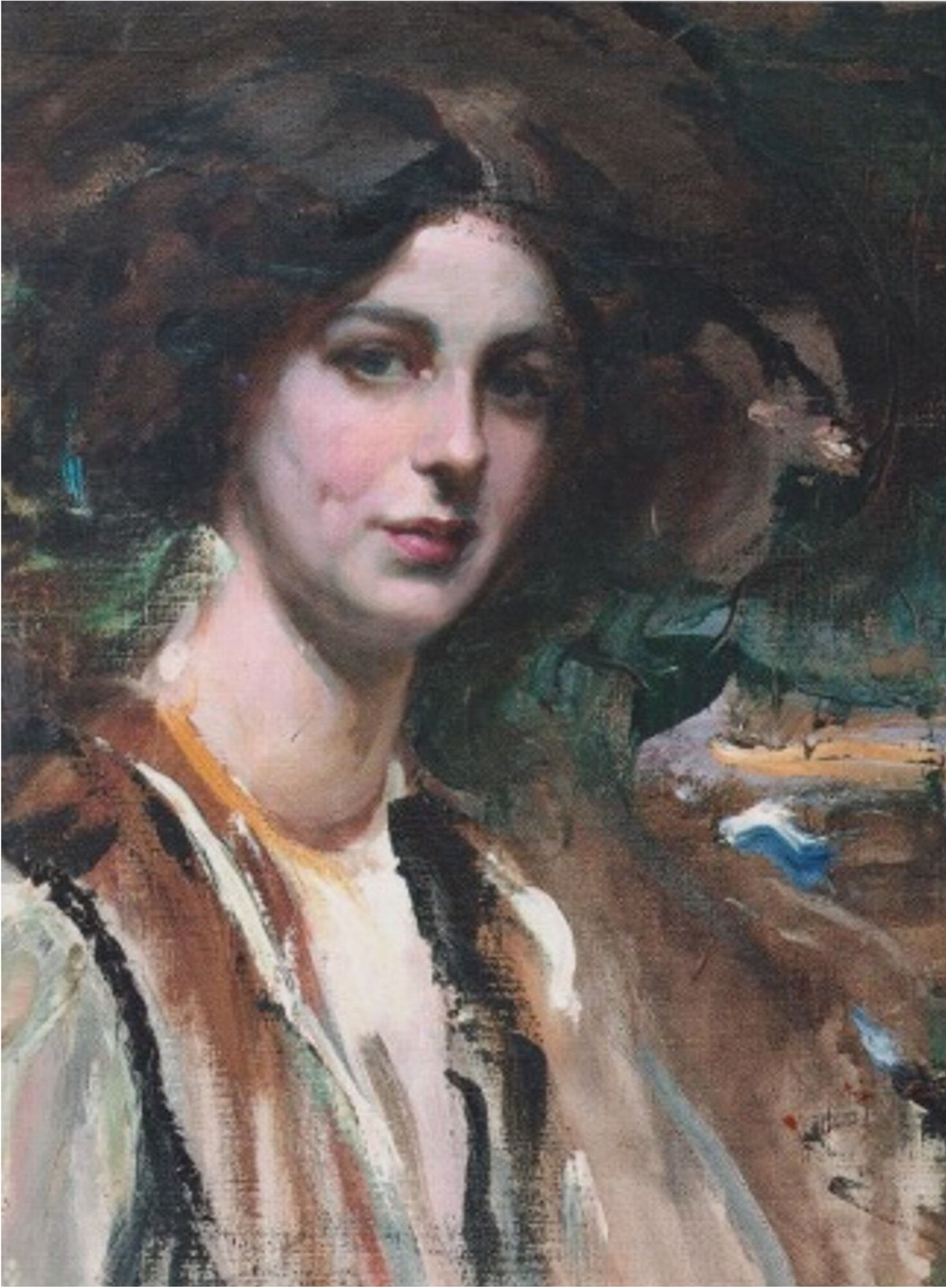
Gypsy Belle by Josephine Muntz-Adams
1917
In 1917, the President was the infamous, but much admired artist and teacher, Max Meldrum. His devotees and followers were known as ‘Meldrumites’, and the gentlemen proudly grew beards similar to their mentor and known as ‘George V’ beards.
It was an era of controversy and argument as the debate over ‘modernism’ divided the ‘traditionalists’ from this new breed of radical painters.
Meldrum’s artistic ideals appealed to these young intellectuals.
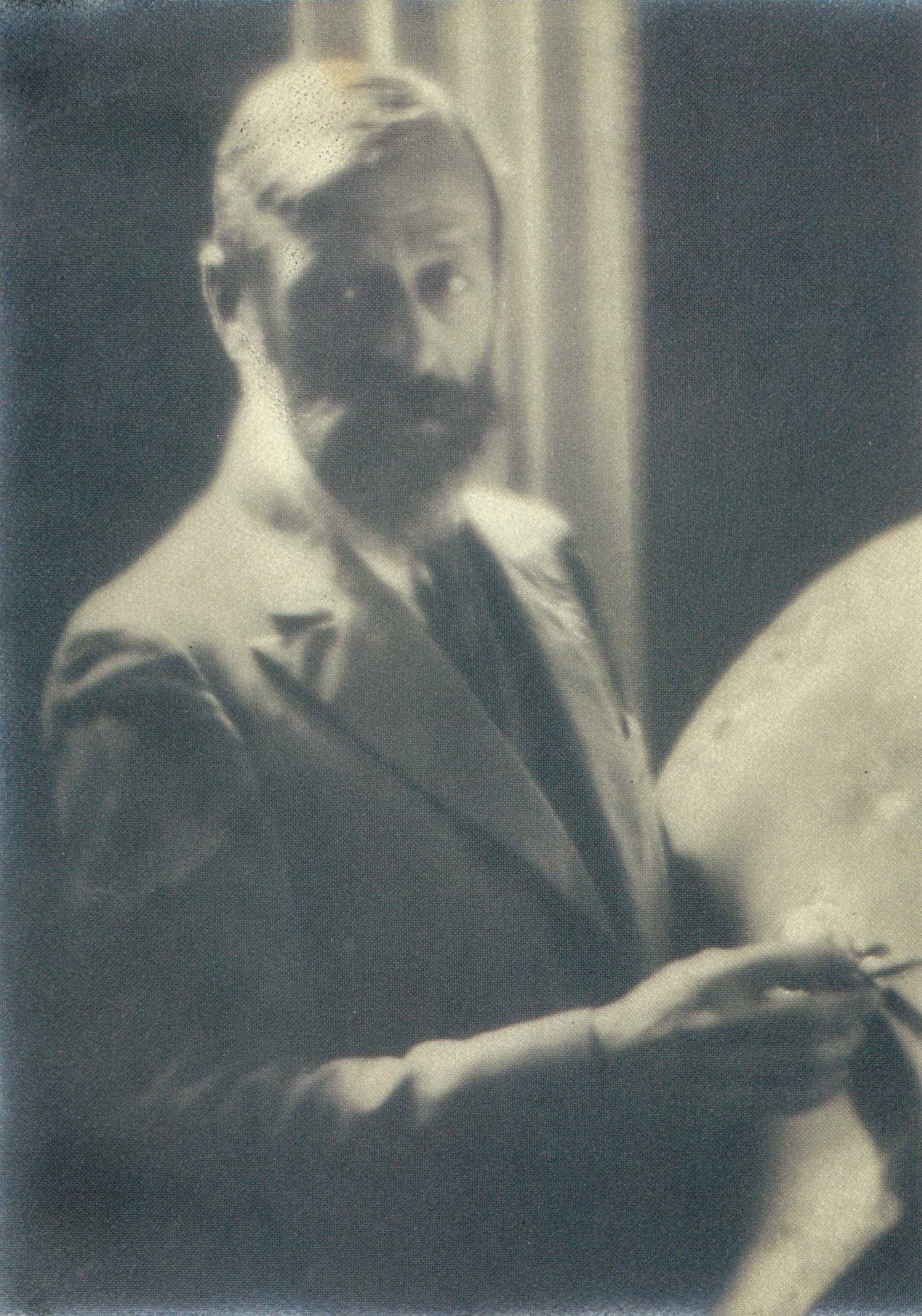
1918
In 1918 President Max Meldrum was displaced by Douglas Richardson, a highly respected, conservative member.
Incensed at Meldrum's defeat, his supporters and students split from the Victorian Artists Society and regrouped at his studio in Hardware Chambers, Elizabeth Street, Melbourne where they formed the 'Twenty Melbourne Painters'.
These Meldrumites forged ahead in the pursuit of, as AME Bale put it, ‘higher art standards and freedom from lay trammels’.
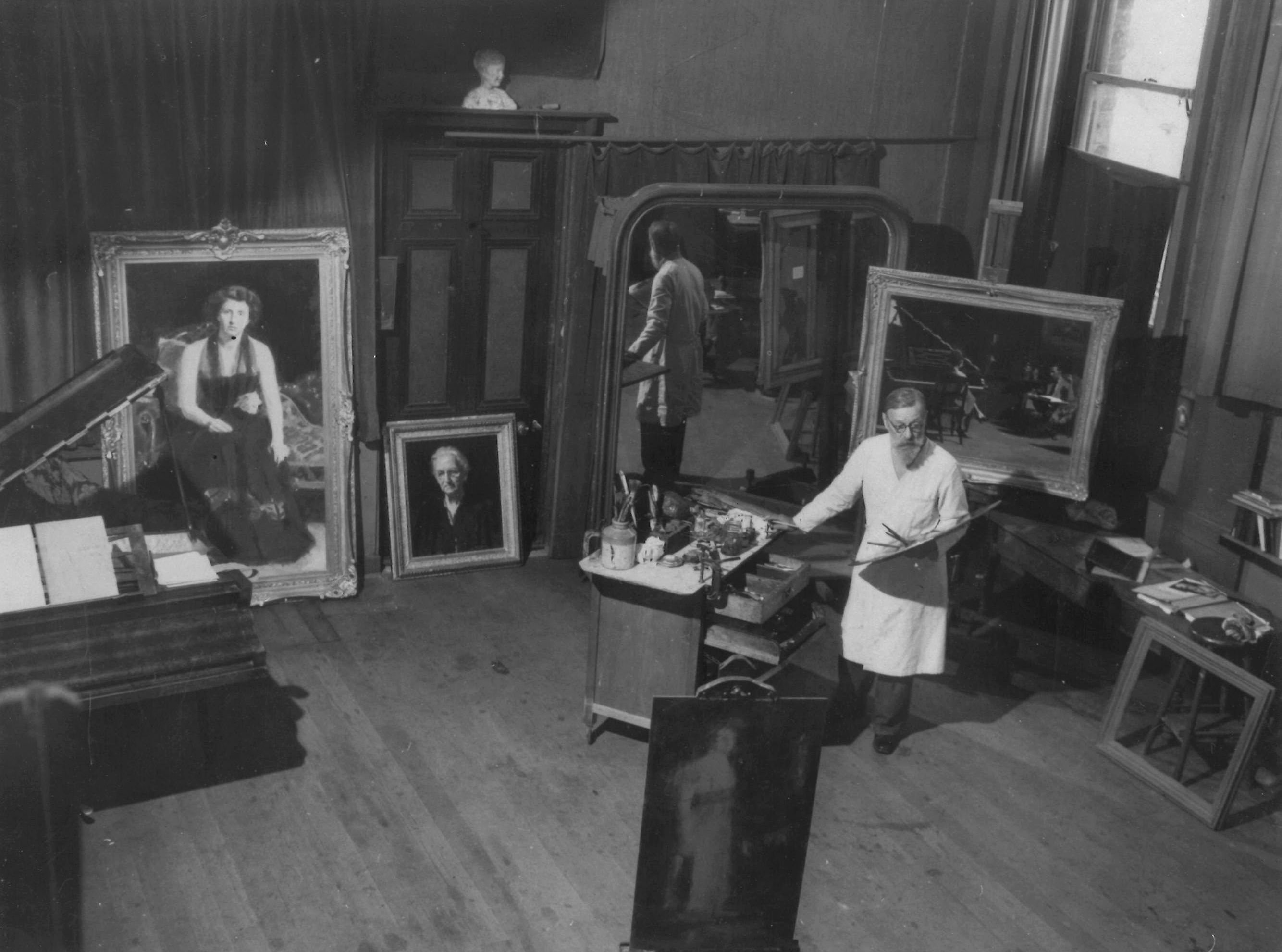
Meldrum in his studio
1937
As new styles of art appeared during the 1930s, a number of ‘breakaway’ groups of artists caused heated debate within local art circles for their radical methods and controversial teaching approaches.
Meanwhile, Melbourne’s ‘Heide’ and ‘Montsalvat’, communes of diverse and colourful artists, sculptors, writers and various ‘hangers on’, flourished.
In 1937 on a special visit to open an Exhibition at the VAS, the Prime Minister Sir Robert Menzies delivered a slamming criticism on the place of ‘Modern Art in Society’.
1947
In 1946, a strong group of sculptors was formed within the Society, which included Stan Hammond, President and much loved mentor and teacher, after whom our South Gallery was named. The first Exhibition of sculpture was held in 1947.
During a career spanning 70 years, Hammond became one of Australia’s most versatile sculptors, specialising in large public sculptures.
He studied under VAS Sculptors Orlando Dutton and Paul Montford, learning the unique skills of bronze sculpture. His works can be seen throughout Australia, one notable piece being the six bronze panels for the entrance to the Albert Park Reserve.
He was President of the VAS for five terms, a Council member for 38 years and honoured with a Society Fellowship.
Our ‘Hammond’ Gallery with its beautiful balcony, remains a constant reminder of this artist’s encouraging and generous contribution to the VAS.
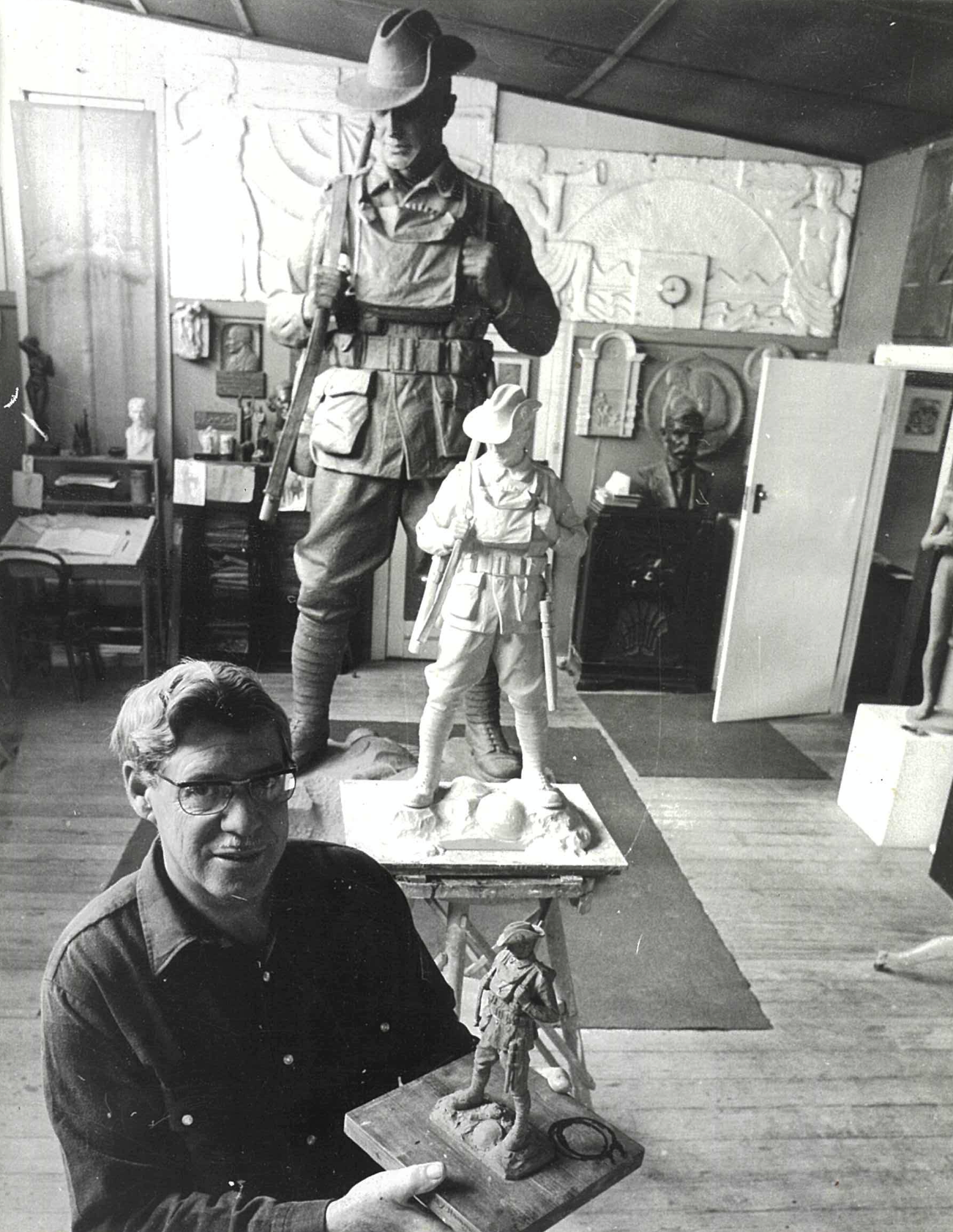
Stan Hammond (1913–2000)
1955
This photograph was taken so that 'a record may be kept which will probably be of interest in the future and so that members may have some idea of how the selection of works to be exhibited, is carried out.
'Every work submitted is given close and careful consideration and finally voted upon, the result being decided by majority vote.
'Three art students are hired to handle the pictures, so that the selectors are not distracted from their task, but can sit quietly and concentrate. Selection starts at 9 a.m. and continues until late afternoon, when the hanging is completed and cataloguing commences.'
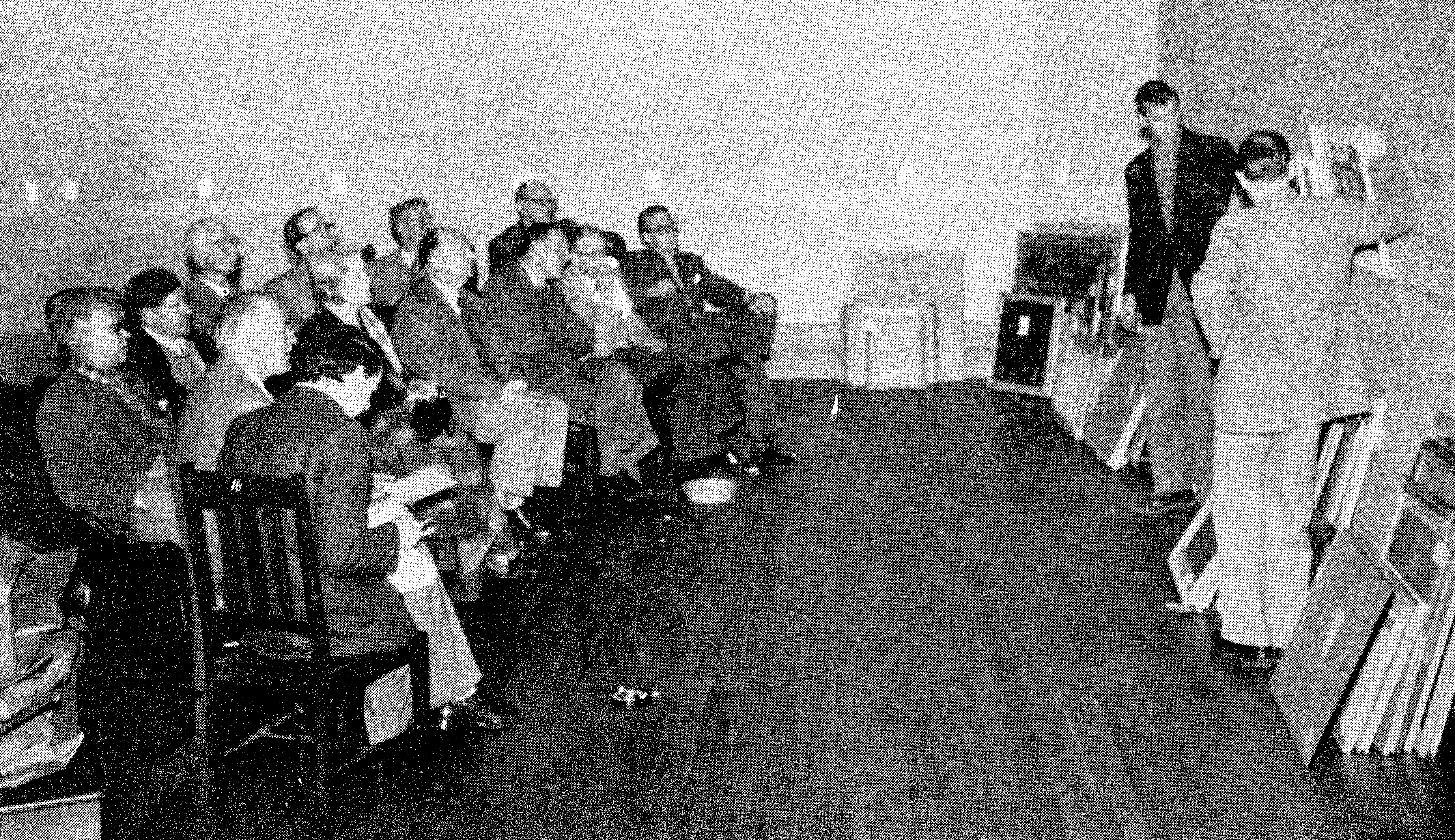
1965
The building was extensively restored under the direction of architect Frank Heath. Some office area used as a music teaching room, was opened up, which reduced the space used by the Melba Conservatorium.
An additional special government grant enabled storerooms and a kitchen to be constructed along with modernised galleries.
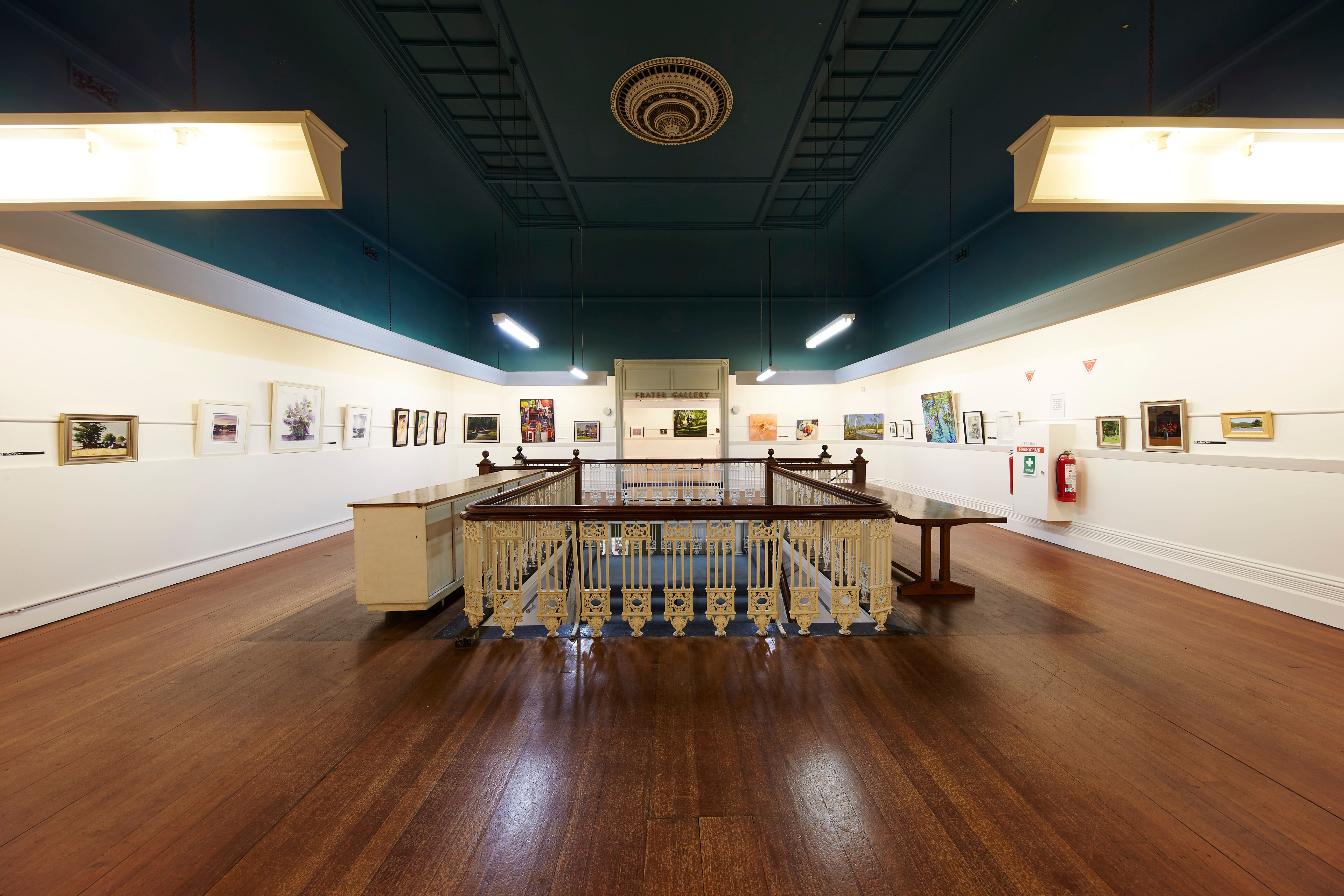
1970
During the 1950s and 60s, much refurbishment of the Galleries took place, and new lighting was installed down stairs in the Studio.
In 1960, the first ‘VAS Newsletter’ was printed, and ten years later we published The Gallery on Eastern Hill, forerunner to our book Victorian Artists Society 1870–2020 Celebrating 150 Years.

1973
In 1973 the Artist of the Year Award was established.
It continues today and to date remains our most prestigious annual prize.
2023 marks 50 years since its inception.
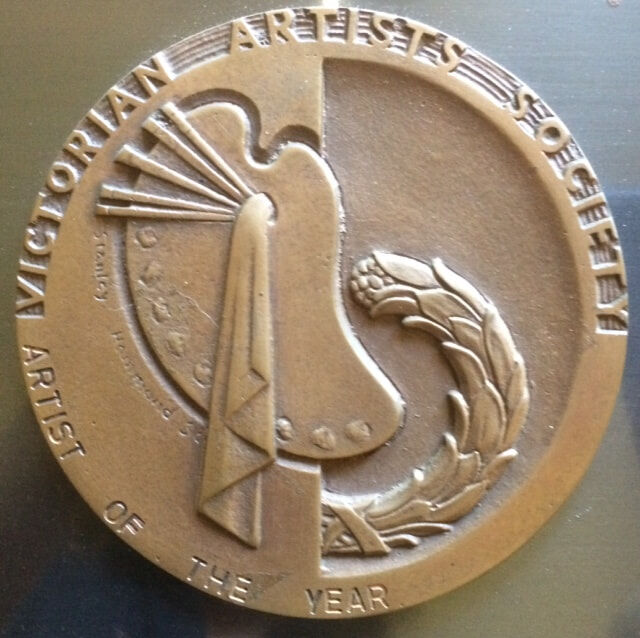
1985
VAS President David Roper began a restoration program. The office equipment was updated, hand rails were installed and carpet was laid throughout the ground floor of the building.
Later works in the 90s included the installation of a security system, lighting in the Cato Gallery and a reception desk.
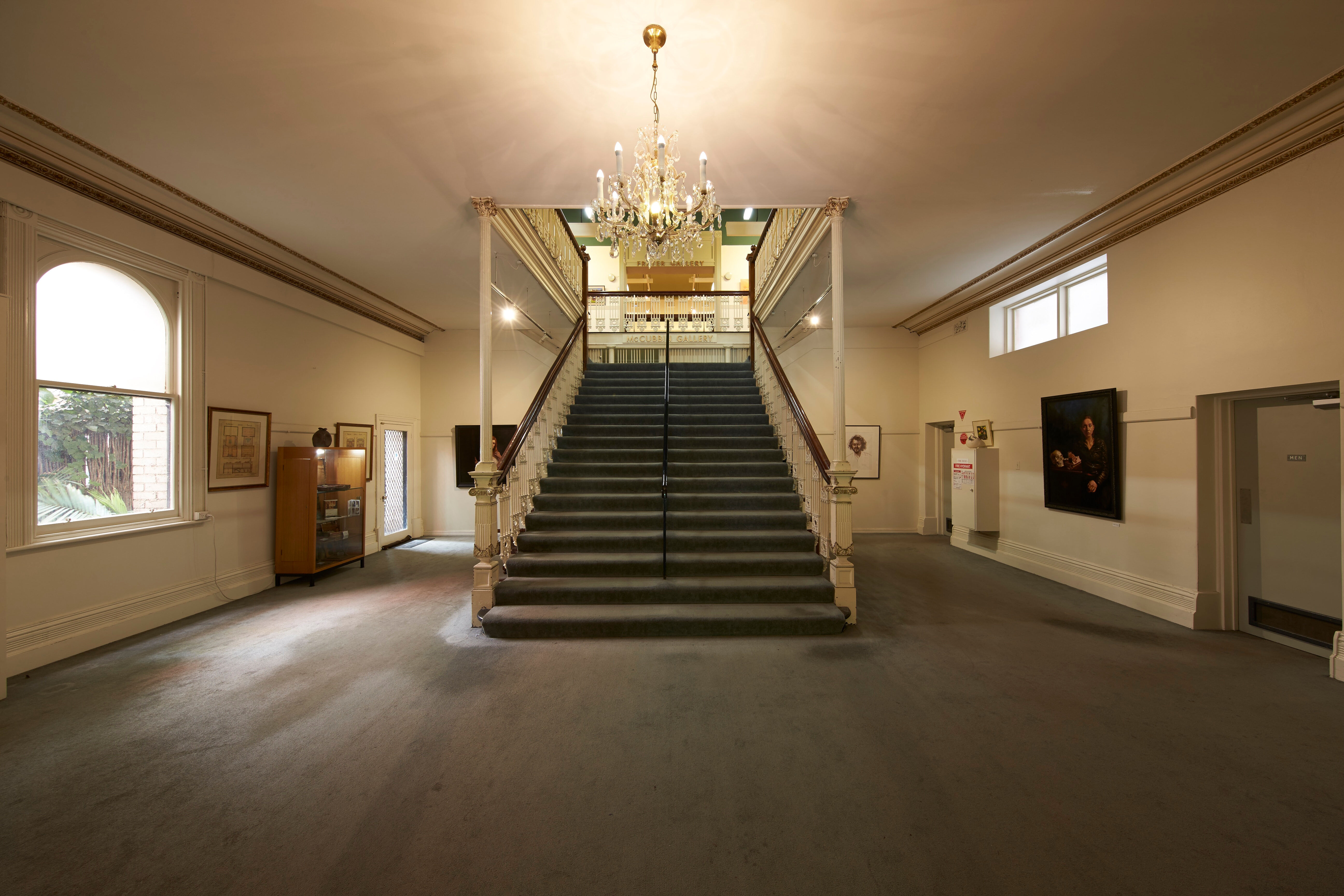
2008
2008 marked the launch of the People Painting People Weekend (Now 'Portrait Painters in Action') under the direction of past VAS President Noel Waite AO.
Its forerunner was the 2004 ‘Days of a Thousand Faces' organised by VAS member Christine Wrest-Smith.
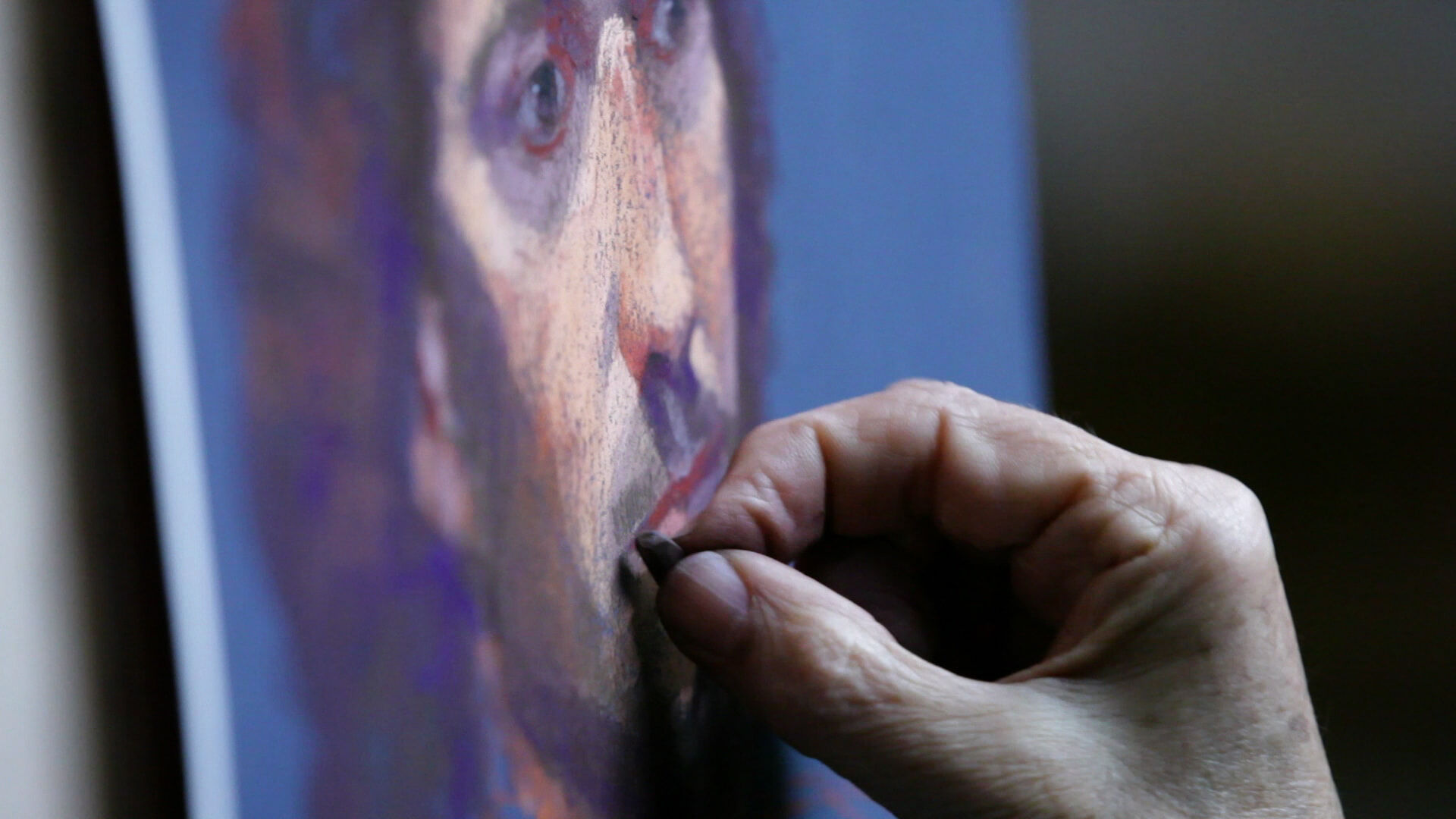
2020
In recent years, the building has undergone major restoration and conservation works, led by architectural firm Chiri-Hall.
Storage spaces that had been constructed under the stairways and in the galleries have been cleared, opening up access to the balcony. Conservation demanded reconstruction of the roof and the three upstairs galleries. Work on the ground floor rebuilt the kitchen and offices.
The studio required several conservation and restoration projects, including removing and replacing water-damaged plaster from the walls and the replacement of the Caneite ceiling with plasterboard. The original floor of Baltic pine, coloured with 150 years of paint and worn by the feet of some of Victoria and Australia’s most iconic artists, has been treated and restored where damaged. Many original features also remain, tables and easels once used by the likes of Frater, with the addition of modern amenities and electrical work that bring the Victorian Artists Society to the intersection of historic tradition and modern innovation.
The next project is the restoration of the courtyard and the inclusion of disabled access.
None of this would have been possible without the generous support of our donors and sponsors.
2020
Her Excellency, the Honourable Linda Dessau AC, Governor of Victoria and Mr Anthony Howard AM QC, officially launched the Victorian Artists Society’s 150th Anniversary Celebrations on the night of Tuesday 10 March 2020.
This coincided with the launch of our 150th Anniversary Book, a 104-page, full colour history of the Society’s existence and its important place in the cultural history of Melbourne and Victoria over the past 150 years.
2023
: three weeks of free events, including artist demonstrations, talks, concerts, drawing sessions and more.
As a celebration of our vibrant history, five exhibitions displayed never before seen historical documents, artefacts and sketches from early members, the VAS Collection, as well as a celebration of 50 years of the Artist of the Year Award.
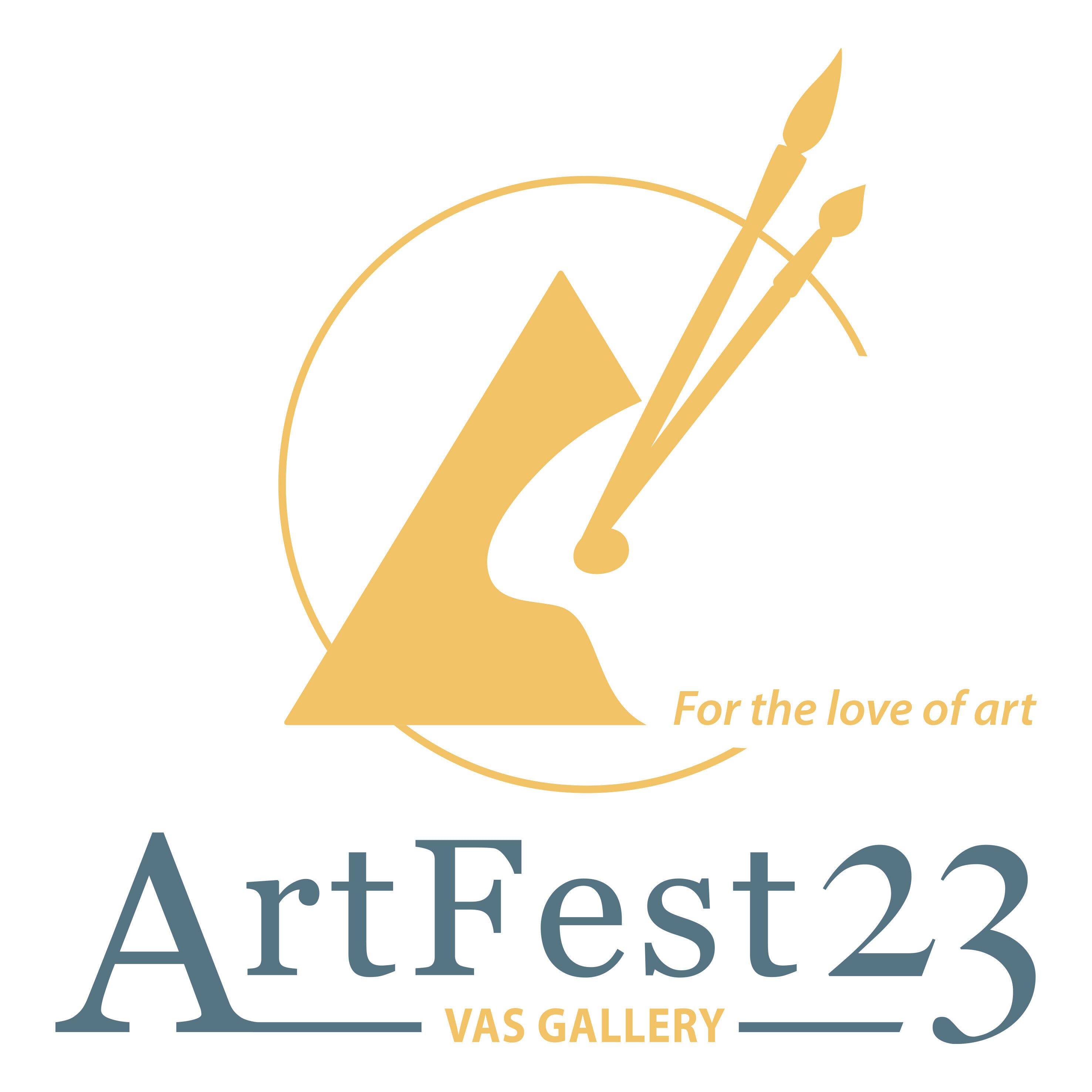
ArtFest23 logo designed by VAS Artist Maria Radun
Acknowledgment of traditional owners.
We would like to pay our respects to the traditional owners of the land on which our building stands, their leaders, past, present and emerging.
